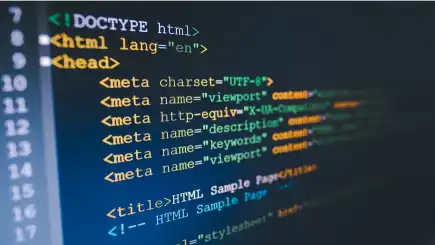Learn CSS with online courses and programs
What is CSS?
CSS, or Cascading Style Sheets, is a fundamental programming language for web design, used to stylize the presentation of HTML-based pages. By using CSS, website designers can build multiple pages with the same formatting. CSS also separates presentation coding from content to improve accessibility and reduce coding time. This functionality allows designers to render multiple versions of a single page for alternate formats, such as mobile or on-screen. CSS is maintained by The World Wide Web Consortium(W3C) and supported by other programming languages, including HTML, XHTML, SVG, and JavaScript.Footnote 1

Browse online CSS courses and programs
Stand out in your field
Use the knowledge and skills you have gained to drive impact at work and grow your career.Learn at your own pace
On your computer, tablet or phone, online courses make learning flexible to fit your busy life.Earn a valuable credential
Showcase your key skills and valuable knowledge.
CSS tutorial and course curriculum
CSS is one of the key languages of the web, and understanding it could qualify learners for many different jobs. If you want to break into the growing field of web design, there are a variety of online CSS classes that can help sharpen your design skills and advance your career.
CSS tutorials often provide learners with a basic understanding of web design, but developing a career building web projects may require more than introductory knowledge. An online CSS course can help learners become familiar with CSS properties, the CSS grid, and style attributes. It can also teach things such as debugging and best practices in web design.
Other front-end web development courses can also round out knowledge of CSS and show how it fits into the larger web development scheme. edX offers a variety of boot camps for interested learners.
CSS website designer jobs
Around the world, professionals at companies large and small use CSS to design websites and applications.
For example, a web designer might use CSS to:Footnote 2
Create style sheets and develop a website’s overall look and design
Debug software
Test a website’s ease of use
Meanwhile, a full-stack developer might use CSS to maintain the accessibility of a website that another designer already built.Footnote 3
The possibilities do not end there. Some other tech positions that use CSS include mobile app developers, data scientists, and product managers.Footnote 4
Web developers and digital designers typically have a bachelor’s degree in a subject related to computer science or programming. More advanced or technical positions could require a master’s degree, while other learners could acquire the necessary skills through boot camps. However, specific requirements will vary depending on the position and company.Footnote 5
For learners who are unsure what career they might want to pursue, an introductory course can be a great place to start.
How to become a web designer online
Strong UX design is key to any functional website. If you’re interested in pursuing a web design career, you could choose to get started by completing a boot camp. A UX/UI boot camp or a coding boot camp can help you develop the skills to start building a web design portfolio. A degree in computer science may also cover CSS and other topics.
After completing an online CSS class, many learners decide to pursue CSS certification as a way of proving their mastery of CSS coding basics. Front-end developer courses can also help get you familiarized with useful programming languages like HTML and JavaScript, preparing you to obtain front-end developer certification.
Every job is different, and a degree isn’t always required to break into the industry. Regardless of your background, you will likely need to prove web design knowledge. That’s why it’s so important to master the basics. If you are new to web design, a good start might be studying design theory, whether that’s through a front-end web development course or a book on how to become a web designer. Once you have a general understanding of theory, design tools, and how the web functions, you can work toward building a design skill set, creating content, developing a portfolio, networking, and ultimately applying to design jobs.
